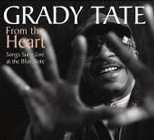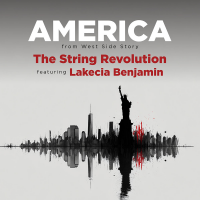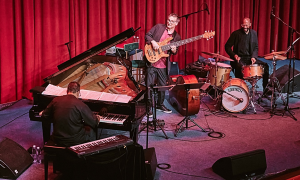Home » Jazz Articles » Profile » Bennie Maupin
Bennie Maupin
Maupin, who grew up in Detroit, is one of those puzzling figures in jazz. Do you know him as the tenor sax of Horace Silver's late '60s quintet? The moody bass clarinet threading its way through Miles' Bitches Brew? A Headhunter? "Musician is a broad title and that encompasses music so the various things that I've been involved in have been very much a part of my evolution as an artist, Maupin intones. "So I'm pleased with a lot of it, that I had those opportunities to participate in all these different things. When you think of the life of any artist, your work should continue to evolve.
Bennie Maupin got his start as a professional musician in a most inauspicious way—through the Four Tops. Brought along to play in New York in 1962, Maupin, who had studied in music conservatory, was quickly enamored of the vibrancy of the city's jazz scene. The first night he saw Monk at the Five Spot and his life was changed. He gave immediate notice to the Four Tops and embarked on a career. But even this momentous decision was fraught with economic peril. The struggle of a working musician is a timeless story and Maupin, who had hospital experience back home, worked a day job taking care of research animals. "I was conflicted because...I had been in New York long enough to see what the community was all about in terms of the music, who was doing well, who wasn't. I got to know who had record contracts and who didn't... That was a very confusing issue to me. I started to wonder. I've got this day gig and I'm doing these little trio hits and I'm playing with some of my friends... It might be a good idea to have some sort of financial security. The job allowed for Maupin to have an apartment and study privately but as more gigs came, Maupin found it harder to get up for work and in the end music won out.
From 1962 to 1972, Maupin lived in New York and participated in some of the early New Thing experiments happening with folks like altoist Marion Brown. "We were neighbors, Maupin recalls. "Some of the guys that I met when I moved to New York were very involved with music that was classified as avant-garde or free jazz... they were just doing incredibly great music as far as I was concerned.
That was followed by immersion in Blue Note post-bop with Silver, Lee Morgan, Andrew Hill and McCoy Tyner. But that was just a step towards what would become Maupin's most recognized period. Having picked up the bass clarinet (" A lot of people who know my work, they don't even think of the saxophone; what they think about is the bass clarinet. ), he was tapped by Miles Davis to participate in the trumpeter's electric period. That might be the apex of anybody's career, but Maupin followed that up with Herbie Hancock's Mwandishi, an extrapolation of Miles' work. This led to the commercially successful Headhunters, the impact of which can be said to have ushered in today's partisan split between electric and acoustic jazz.
Maupin's career would seem to have been set after residing in such lofty aeries, but for such a creative and probing musician, "Experiencing burnout is a really serious thing that we can confront sometimes. You can be very successful and you can be very much at the top of your field; there comes a time when you are ready to move on.
He moved to Los Angeles, became involved in Buddhism and even went back to school, not for music but to fill in gaps he had in his general education. Though he continued to play music, the days of playing in front of thousands of people with the Headhunters were a thankful memory. "Many people haven't seen me play live because I haven't played live much in the past almost 20 years, he says. "Not like I was in the '60s and '70s when I was everywhere. That period came to an end, like periods do and I was happy that it did.
But those years were spent growing and gestating, an opportunity to "rethink some of my ideas about my music . The result is Penumbra, a distillation of Maupin's work with Hancock and Miles but also Chick Corea, Woody Shaw and Sonny Rollins. Cryptogramophone expressed great interest in the 2003 recording and a Maupin renaissance began. Though he, like many others, is still better known in Europe, his stateside visibility is increasing through the album and performance. "Finding ways to get the music out there is always a major issue for artists who do the kind of music I do, he affirms. "But I feel really good because I've been able to do it and do it successfully and there haven't been any major collisions.
Recommended Listening:
· Marion Brown—Juba-Lee (Fontana, 1966)· Miles Davis—Bitches Brew (Columbia-Legacy, 1969)
· Herbie Hancock—Mwandishi: The Complete Warner Brothers Recordings (Warner Brothers, 1969-72)
· Lee Morgan—Live at the Lighthouse (Blue Note, 1970)
· Bennie Maupin—The Jewel in the Lotus (ECM, 1974)
· Bennie Maupin Ensemble—Penumbra (Cryptogramophone, 2003)
Tags
PREVIOUS / NEXT
Support All About Jazz
 All About Jazz has been a pillar of jazz since 1995, championing it as an art form and, more importantly, supporting the musicians who make it. Our enduring commitment has made "AAJ" one of the most culturally important websites of its kind, read by hundreds of thousands of fans, musicians and industry figures every month.
All About Jazz has been a pillar of jazz since 1995, championing it as an art form and, more importantly, supporting the musicians who make it. Our enduring commitment has made "AAJ" one of the most culturally important websites of its kind, read by hundreds of thousands of fans, musicians and industry figures every month.



























